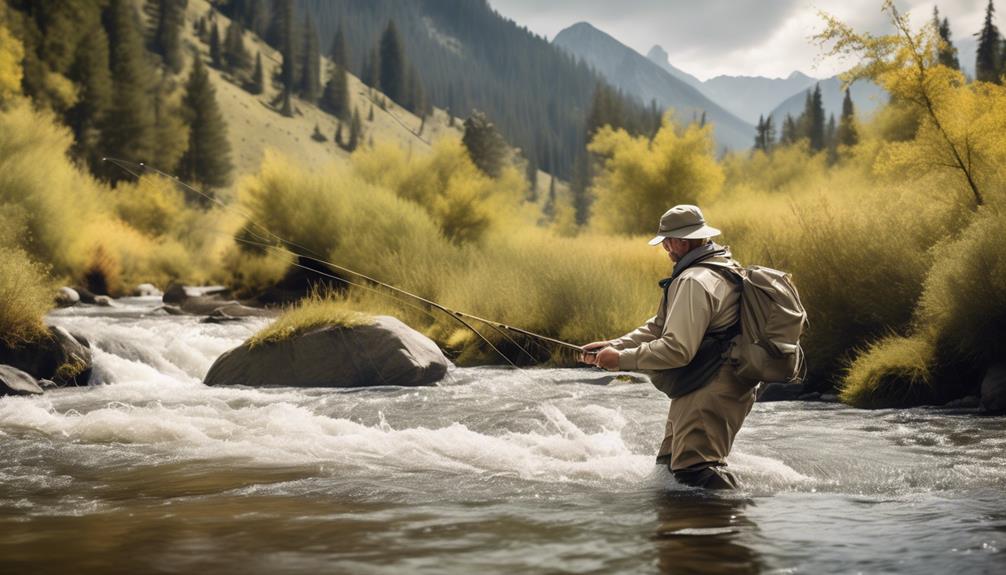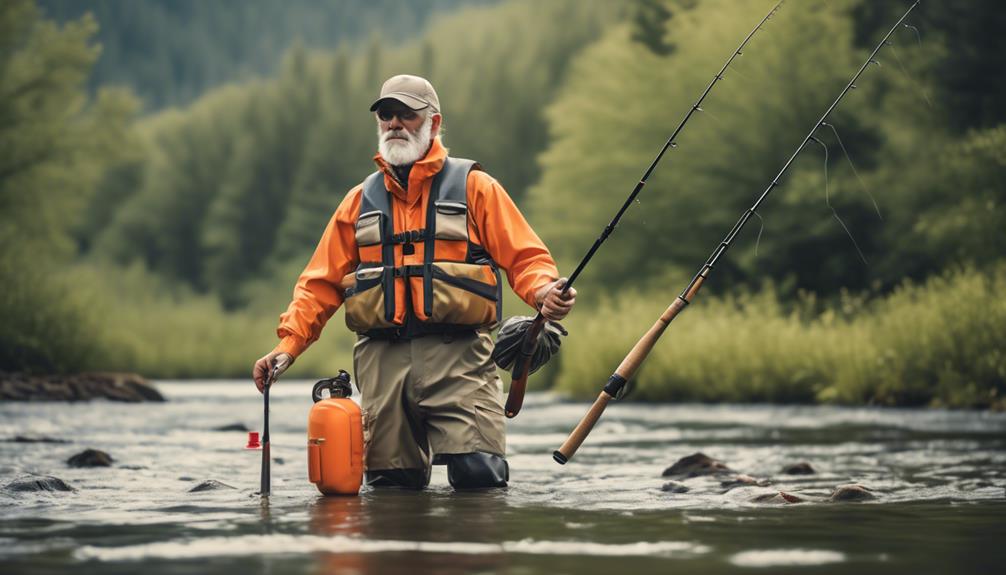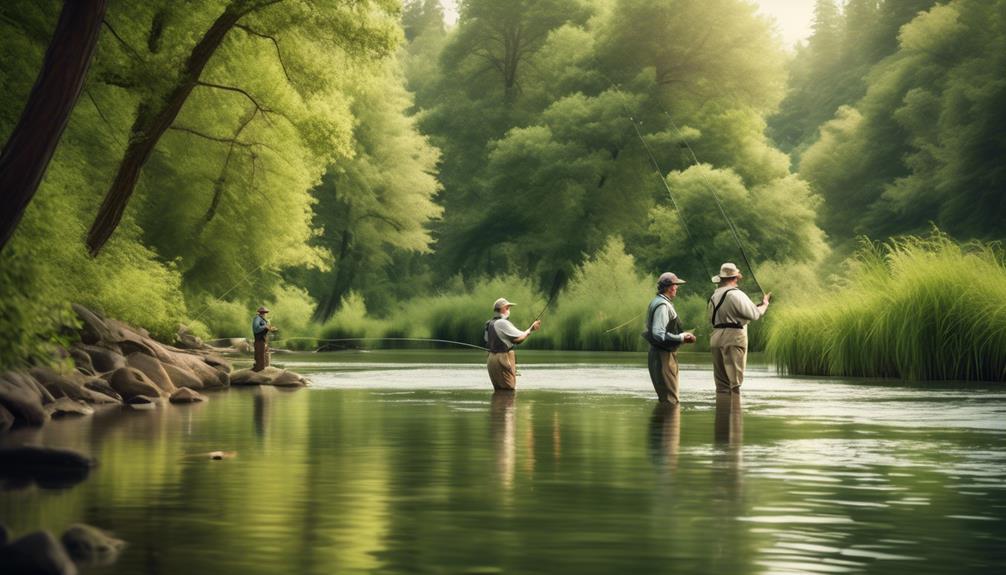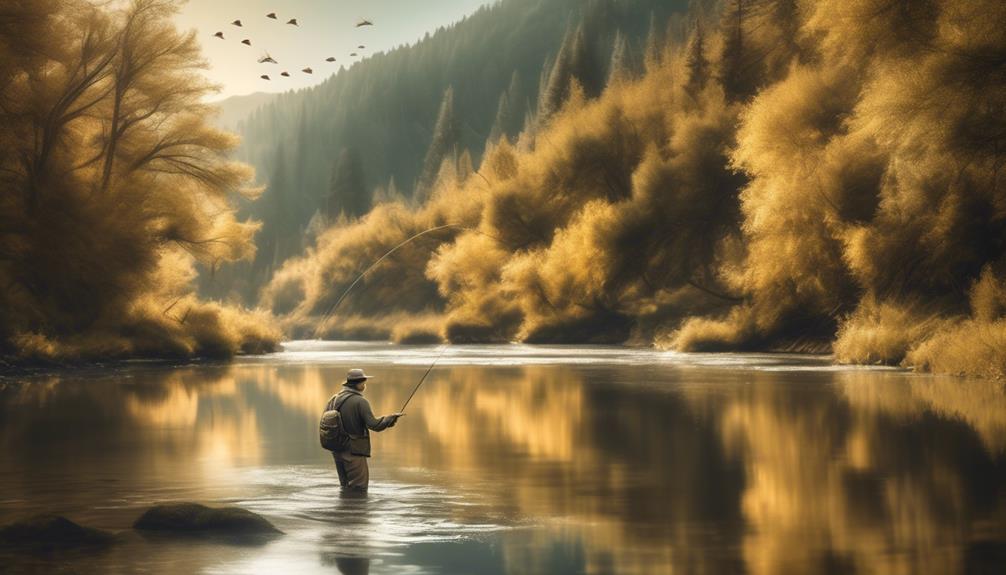When it comes to fly fishing, safety precautions are as essential as an angler's fly rod. Just as you wouldn't head into the woods without a compass, it's crucial to approach fly fishing with the same level of preparedness and caution.
From assessing gear to understanding water conditions and being mindful of wildlife encounters, there are numerous safety measures that every fly fisher should consider. But what are the most vital precautions, and how can they ensure a successful and secure day on the water?
Proper Gear Inspection
Before heading out for a fly fishing trip, it's essential to thoroughly inspect your gear for any signs of wear or damage. Proper gear maintenance is crucial for a successful and safe fly fishing experience.
Start by going through your equipment checklist. Check your fly rod for any nicks, cracks, or loose guides. Inspect the reel for any signs of corrosion or damage. Make sure the fly line isn't frayed or damaged, as this can affect your casting and fishing abilities. Additionally, examine your waders for any leaks or tears, paying close attention to the seams and neoprene booties.
Next, inspect your flies, leaders, and tippets. Ensure that your flies aren't rusted and that the hooks are sharp. Check your leaders and tippets for any abrasions or weak points. It's crucial to have strong and reliable connections between your fly line and the fly to prevent losing a catch.
Lastly, don't forget to inspect your accessories such as nippers, forceps, and floatant. These small tools are easy to overlook but are essential for a smooth fishing experience.
Understanding Water Conditions
To gauge the prevailing water conditions, assess the flow rate, temperature, and clarity of the water before embarking on your fly fishing excursion. Water current assessment is crucial for understanding the behavior of fish and choosing the right spot for fishing.
Start by observing the flow rate of the water. A faster flow generally indicates deeper and more oxygenated water, which attracts fish. However, excessively fast currents can make fishing challenging and unsafe. On the other hand, slow-moving water may be ideal for certain fish species but could also indicate low oxygen levels.
Next, consider the water temperature. Different fish species have specific temperature preferences, so understanding the water temperature can help you target the right species. Additionally, temperature affects fish metabolism, which in turn influences their feeding patterns.
Lastly, assess the water clarity. Clear water is ideal for visual hunting fish, while murky water may favor species that rely on other senses to locate prey.
When selecting a fishing spot, consider these factors in conjunction with your target fish species. Look for areas where the current brings food to the fish, such as seams, eddies, or riffles. These are often the best places to find fish.
Weather Awareness
Assessing the prevailing weather conditions is essential for fly fishing safety, as it directly impacts water flow, temperature, and clarity, influencing fish behavior and ultimately your fishing success. When planning a fly fishing trip, clothing selection is crucial. Dress in layers to regulate body temperature, and choose moisture-wicking fabrics to stay dry. Be sure to wear appropriate footwear for the conditions, including sturdy boots with good traction.
Additionally, monitoring the weather forecast before and during your fishing expedition is vital. Keep an eye out for any changes in wind speed and direction, as this can affect casting accuracy and the behavior of insects, which in turn influences fish feeding patterns. Sudden temperature fluctuations can also impact insect hatches and fish activity, so stay informed about any expected weather changes.
Being aware of weather conditions isn't just about comfort, but also about safety. Sudden storms can pose significant risks, and being caught unprepared in inclement weather can be dangerous. Always have a plan for seeking shelter if needed, and consider carrying a small, packable rain jacket to stay dry in case of unexpected rain. By staying attuned to weather patterns, you can ensure a more enjoyable and safer fly fishing experience.
Emergency Preparedness
Monitoring your surroundings and being prepared for potential emergencies is crucial for ensuring the safety of yourself and others during your fly fishing expeditions. When you're out on the water, you need to be ready for any unforeseen circumstances that may arise. Here are some key aspects of emergency preparedness to keep in mind:
- First Aid Kit: Carrying a well-stocked first aid kit is essential. In the event of minor injuries like cuts, bruises, or insect bites, having the necessary supplies readily available can make a significant difference in how quickly and effectively you can address the situation.
- Communication Protocols: Establishing clear communication protocols with your fishing companions is vital. Make sure everyone knows how to reach help in case of an emergency. Have a plan in place for contacting emergency services, and ensure that everyone is familiar with the designated meeting points or rendezvous locations.
- Emergency Contacts: Always carry a list of emergency contacts, including local emergency services, park rangers, and fellow anglers' contact information. This can be invaluable in situations where immediate assistance is required.
Being proactive about emergency preparedness not only enhances your safety but also contributes to a more enjoyable and stress-free fly fishing experience. By prioritizing first aid readiness and effective communication, you can navigate potential emergencies with confidence and composure, allowing you to focus on the joy of the sport.
Casting Safety
Ensure the area is clear of obstacles and other anglers before beginning your casting. Proper casting technique not only enhances your fishing experience but also plays a crucial role in injury prevention.
Before casting, check for any overhanging branches, rocks, or other potential obstacles that could hinder your movements. Once you have confirmed the area is clear, focus on your casting technique. It's essential to maintain a firm grip on the rod while also keeping your wrist straight during the casting motion. This helps in preventing injuries such as strains or sprains.
When casting, make sure to be mindful of your surroundings and the position of other anglers. Accidentally hooking another angler can result in severe injuries, so always be aware of the location of people around you. Additionally, when casting in windy conditions, be cautious of your backcast to avoid potential accidents.
Proper weight distribution is also crucial for injury prevention during casting. Distribute your weight evenly on both feet to maintain balance and stability. This helps in preventing falls or slips, especially when fishing in uneven or slippery terrain.
Wildlife Encounter Protocols
Before you venture into areas known for fly fishing, it's essential to be mindful of potential wildlife encounters, especially after ensuring the area is clear for casting. Wildlife encounters can be exciting, but they also require caution and respect for the animals and their habitat. Here are some crucial protocols to follow when encountering wildlife while fly fishing:
- Observe Animal Behavior: When you come across wildlife, take a moment to observe their behavior. Are they exhibiting signs of agitation or distress? It's important to give them space and not disturb their natural activities. Keep in mind that some animals may see you as a threat and act defensively.
- Maintain Environmental Awareness: Being environmentally aware means understanding and respecting the natural habitats of the wildlife. This includes not leaving behind any trash or disturbing the surroundings. Be mindful of where you step and avoid trampling on vegetation, as some species may be fragile and easily damaged.
- Practice Caution and Preparedness: Always be prepared for wildlife encounters by carrying bear spray or other deterrents if you're in bear country. Additionally, knowing basic first aid and how to handle unexpected encounters with wildlife can make a significant difference in ensuring your safety and the well-being of the animals.
Stream Navigation Techniques

Navigating streams while fly fishing requires attentiveness to water flow and potential obstacles. When navigating a stream, it's crucial to be aware of river hazard identification and reading currents. Look for signs of fast-flowing water, submerged rocks, and undertows, and always prioritize safety by avoiding these hazards. Remember that understanding how water moves around obstacles won't only help you navigate the stream effectively but also enhance your fishing experience.
Streamside etiquette is equally important. Be mindful of other anglers and outdoor enthusiasts by giving them space and respecting their fishing access. When passing by fellow anglers, keep your distance and avoid disrupting their fishing spots. Additionally, be cautious not to trample on vegetation or disturb wildlife along the stream. By following streamside etiquette, you contribute to a harmonious and enjoyable environment for everyone.
As you move through the stream, stay observant of your surroundings. Pay attention to changes in water depth and be prepared to adjust your footing accordingly. Always test the stability of the ground before taking a step, especially in areas with uneven terrain. By staying mindful of your movements and surroundings, you can navigate the stream safely and effectively.
Safe Wading Practices
When wading in a stream, always assess the water depth and current strength to ensure your safety and stability. Safe wading practices are crucial for an enjoyable and secure fly fishing experience. Here are some essential tips to keep in mind:
- Equipment Maintenance: Regularly inspect and maintain your wading gear, including waders and boots, to ensure they're in good condition and provide adequate support. Faulty equipment can compromise your safety while wading.
- Balance Training: Engage in exercises to improve your balance and stability. Practicing yoga or simply standing on one leg can help enhance your ability to navigate uneven and slippery streambeds.
- Stream Etiquette: Respect other anglers and the environment by being mindful of your impact on the surroundings. Avoid disrupting the natural habitat and be courteous to fellow anglers sharing the water.
It's also important to stay informed about potential river hazards such as strong currents, deep holes, and hidden obstacles beneath the water's surface. Being aware of these risks can help you make informed decisions while wading.
Frequently Asked Questions
What Are the Best Types of Flies to Use in Different Water Conditions?
When fly fishing in different water conditions, it's crucial to choose the right flies. Match the hatch for optimal success. Remember river etiquette and respect other anglers. Stay safe and have fun out there!
How Can I Prepare for Unexpected Weather Changes While Fly Fishing?
When fly fishing, always be prepared for unexpected weather changes. Proper clothing and emergency supplies like a waterproof jacket, extra layers, and a first aid kit are vital. Stay alert and adaptable to ensure safety.
Are There Any Specific First Aid Measures I Should Take for Common Fishing Injuries?
When fly fishing, it's important to know first aid for common injuries. Always carry a first aid kit and be prepared for cuts, hooks, and falls. Stay safe by being cautious and respecting the natural habitat.
What Should I Do if I Accidentally Hook a Bird or Other Wildlife?
If you accidentally hook a bird or other wildlife while fishing, stay calm. Slowly reel in the line and carefully release the animal. Practice ethical angling to avoid harm. Responsible handling and conservation awareness are vital for wildlife rescue.
How Can I Avoid Disturbing the Natural Habitat While Navigating Streams for Fishing?
When navigating streams for fishing, it's important to practice stream etiquette and prioritize wildlife preservation. Be mindful of your surroundings, avoid trampling vegetation, and handle fish with care to minimize disturbance to the natural habitat.
Conclusion
So, remember to always inspect your gear,
understand water conditions,
stay aware of the weather,
be prepared for emergencies,
practice safe casting,
know how to handle wildlife encounters,
navigate streams carefully,
and practice safe wading.
Following these safety precautions will ensure a successful and enjoyable fly fishing experience.
Stay safe and tight lines!



